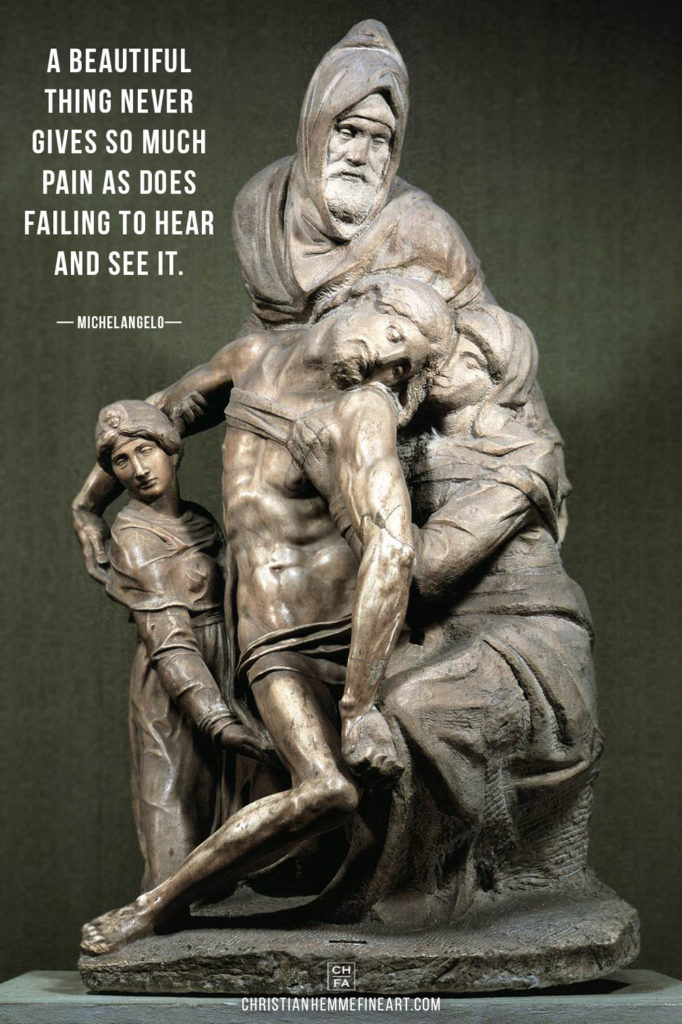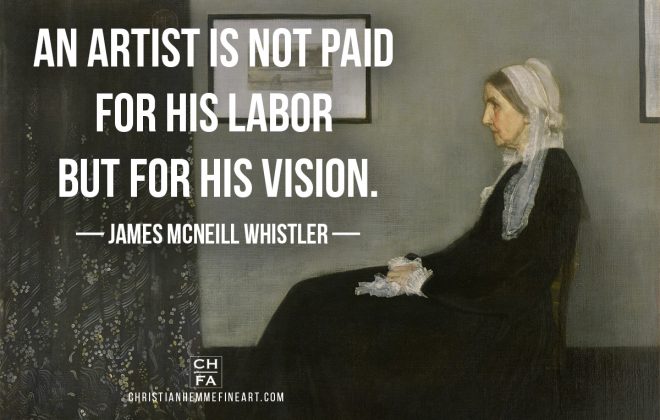Explosive Visual Noise | Artist Quotes | Michelangelo
“A beautiful thing never gives so much pain as does failing to hear and see it.”
—Michelangelo
Michelangelo di Lodovico Buonarroti Simoni, Italian sculptor, painter, architect, and poet of the High Renaissance. “He exerted an unparalleled influence on the development of Western art.”
Explosive Visual Noise
BOOM! BOOM BOOM! The bass beat hit us like repeated punches on a boxer’s bag. The concrete walls of our building stood no chance against those assaulting sound waves. The driver of a passing car was listening to his music…and obviously wanted the world to know about it. I paused in the middle of my workshop’s morning demo to let the air still before carrying on.
On another occasion, I pulled over at a soccer complex to enjoy a spectacular sunset. Yellows turned to oranges turned to reds as blues transformed from pale cerulean to vibrant cobalt to deep ultramarine. Trees faded from dark green to deep violet to inky black. In the air above, birds chirped and insects buzzed with the usual chorus of early summer. Beautiful. And then soccer practice ended at the far fields. Within minutes (and at the most spectacular bit of the sunset), dozens of teens in their cars drove past me. And they did not go gentle into that good night. No. They went hip-hopping and rock-n-rolling.
Noise. It’s everywhere.
But it’s not just audial.
In last week’s Artist’s Insight, I mentioned that Modern and Postmodern Art largely focus on the random, bizarre, macabre, and chaotic. “Shock factor” supersedes even “originality” for a piece to have value in this genre. (In fact, the “piece” doesn’t even have to exist!)
[bctt tweet=”…noise in the visual sense. The world just has too much of it. —Christian Hemme” username=”chemmefineart”]
In my estimation, this equates to Noise—noise in the visual sense. The world just has too much of it.
And it shapes who we are.
Parallels of Profession
Now don’t get me wrong after reading my first paragraphs: I love good rock n’ roll! I even enjoy some good pop music. But the days of Johnny Cash and The Beatles seem to have largely gone away. (How much more so the original “pop” music: Bach’s gravitas or Mozart’s “notiness.” I actually found a fun article about candidates for the very first pop song.) Nowadays, judging by the Billboard charts, a multitude of people listen to albums that exude either inanity at best or criminal violence at worst.
The different facets and disciplines of art often have parallels. And I find it so here with visual art and audial art; the two disciplines seem to share this unfortunate tendency.
A top-ten pop song might get stuck in our heads for weeks…yet has such fluffy lyrics we never really bother thinking about what the song says. However, we certainly couldn’t say we’ve learned or grown at all. This sort of tune equates in my mind to much contemporary art. Lots of bright colors, big textures, and fun themes…but we have no idea what the artist wants to say. And honestly, we probably don’t really care to know.
Then there’s the music that unabashedly embraces horrors. Frequent use of racial slurs. Authority figures fought against and crushed. Children exposed to nightmarish situations. Woman routinely degraded, abused, and exploited. Outright murder.
Now not all these themes are frequently depicted in mainstream art. However, if you begin to look at artwork with these things specifically in mind, I think you’d be unpleasantly surprised. A cursory glance at several prestigious international art competitions seems to rather confirm it. And as I mentioned in my “Capture Everything” Artist’s Insight, hopelessness and despair is written at large across the canvases of these exhibitions. Could this sort of pessimism result from a culture accepting these sorts of horrors as “entertainment?”
The Minority of Quietude
I’ve long been the type of person who occasionally turns off the car stereo just to be alone with my thoughts. And as my sunset-at-the-soccer-fields story narrates, I also enjoy the solitude of nature. But I fear I’m part of a growing minority—a minority sliding farther into obscurity. Nowadays it seems most people literally can’t tolerate quietude or stillness. A TV somewhere has to be on. Music has to be in the background. Anything, ANYTHING to fill our minds and avoid silence.
Why is that?
I believe it’s so we don’t have to think.
Because thinking is where the questions lie waiting. The existential types of questions. The questions that sometimes seem impossible to answer, and are certainly always difficult. Thinking means asking “Who am I? Where did I come from? Why am I here? Where am I going?”
Under the (Canvas) Surface
But that led me to wonder—why is shock-and-awe Modern and Postmodern Art so popular? I mean…paintings don’t exactly drown out our inner dialogue, right?
Well it might not override that dialogue in the same way as music, but it sure can guide it! As I said in last week’s discussion about “Essence Verses Exactness,” art should always be visual storytelling. Art should convey something. So where do works that highlight random, bizarre, macabre, and chaotic themes take our thoughts? What emotions, desires, or frames of mind do these pieces instill?
If we regularly ask those questions of works of art, I think we’ll see a lot of the modern scene is simply harsh, grating, screeching noise. Devoid of creativity. Lacking in skill. Unblushingly strident in its negative message.
[bctt tweet=”Whether we collect or create it, our art communicates. What does yours say? —Christian Hemme” username=”chemmefineart”]
Whether we collect or create it, our art communicates. What does yours say? Let me encourage you not to give in to the noise.
Shape who we are.
Questions: Do you feel the world has become overrun with noise? Do you agree with the parallel between audial and visual noise? What messages do you want the artwork you collect or create to convey? Let us all know in the comment section below!





I’ve really enjoyed these insights of yours. I think that they probably have broad appeal and that you aren’t really stepping on toes so much as just reminding us on what is important…it’s so easy to get swept up in the currents of modern-day living. They’ve been an encouragement to me. Looking forward to your next insightful insight.
Thank you for those words Mr. Jekel! I do hope I’m not stepping on toes; that’s certainly not my intention. As you said, I simply hope to challenge artists and collectors alike to think more deeply about the art they create, purchase, or endorse. I’m so glad these Artist’s Insights have been an encouragement to you!
Really appreciate your thoughts and what you are sharing in your Artist’s Insights. I totally agree with all you’re saying about all the noise and harshness of some of today’s music and art. As artists we must work hard against such a flow of negativity and despair and counter with a sword of light and beauty and peace.